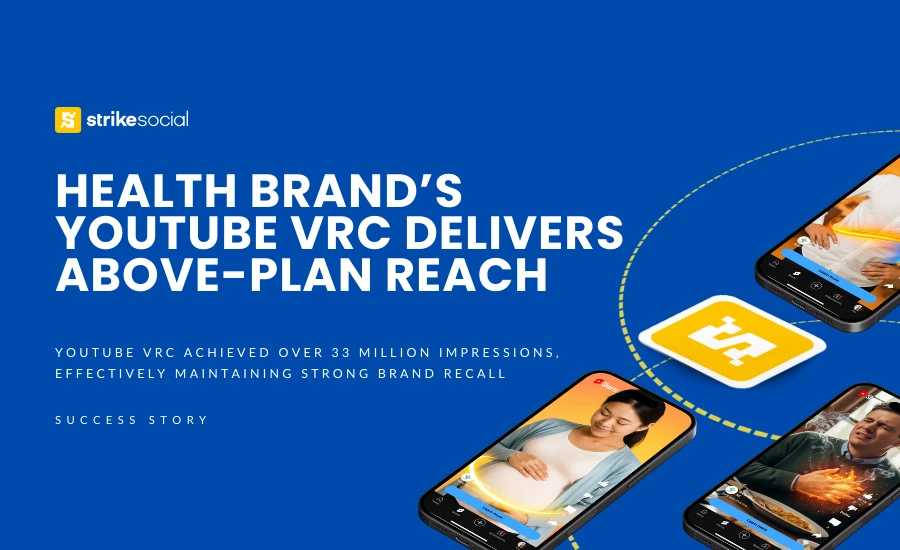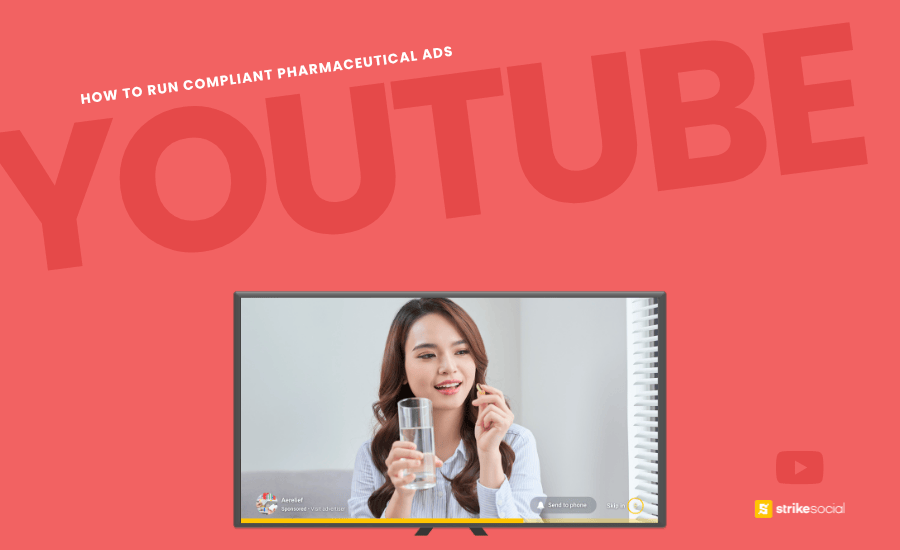Strike Overview
- Learn how to plan, certify, and launch compliant pharmaceutical YouTube ads that meet Google’s Healthcare and Medicines Policy.
- Understand the four key pillars of compliance and how they shape successful, regulation-ready YouTube campaigns for pharmaceutical brands.
- Explore best practices in pharmaceutical advertising, and how partnering with a Google Premier Partner ensures both compliance and performance.
Jump to Section
The Definitive Guide to Running Compliant Pharmaceutical Ads on YouTube
Healthcare and pharmaceutical ad spending is projected to reach $24.77 billion in 2025, a 13.3% year-over-year increase, as brands continue to shift budgets from traditional media to digital video and CTV platforms.
As YouTube becomes the new primetime for pharmaceutical advertising, this presents both opportunities and challenges. While the platform offers unmatched reach and targeting capabilities, it also comes with stringent advertising regulations that can make compliance a complex task.
Here, you’ll learn how to plan and execute compliant, high-performing pharmaceutical YouTube ads: from understanding Google Ads certification requirements to aligning with pharmaceutical advertising regulations. We’ll unpack best practices for pharmaceutical advertising on YouTube, show how to navigate policy nuances, and outline clear steps to keep your campaigns compliant while driving results.
Why YouTube Matters for Pharmaceutical Brands
The modern patient journey starts online, and YouTube plays a dominant role. For pharmaceutical companies, this means YouTube ad campaigns are now central to any effective healthcare advertising strategy.
The New Primetime for Pharmaceutical YouTube Ads
Capturing an estimated 40% share of multichannel video programming, YouTube now delivers the reach, scale, and targeting precision that traditional broadcast once offered, but with added measurability and cost efficiency.
For advertisers, pharmaceutical YouTube ads represent a direct, data-driven way to reach the same households that once tuned in to primetime TV.
Reaching Patients and Healthcare Professionals
Today’s audiences turn to YouTube not just for entertainment but for education. Patients research symptoms, explore treatment options, and seek out first-hand experiences, while healthcare professionals use the platform to stay informed about new therapies and innovations.
U.S. pharmaceutical companies have noticed this shift in behavior, and in 2024, have invested $19.45 billion in online marketing, with budgets expected to rise by another 10.5% in 2025 as brands prioritize digital video. YouTube, in particular, has become a strategic touchpoint—a space where pharmaceutical advertisers can deliver relevant, compliant, and high-impact content precisely when audiences are most engaged.
Pfizer, for instance, increased its YouTube ad spend by 3%, emphasizing the platform’s proven ability to build brand trust, raise awareness, and inspire meaningful patient action. For pharmaceutical marketers, the opportunity lies in meeting audiences where they seek credible information, through thoughtful, compliant storytelling that drives both education and engagement.
Further Reading

Which Audience Targeting Strategy Drives Better YouTube Ad Performance?
From contextual targeting that aligns with content themes to audience targeting that zeroes in on user intent, both strategies bring value. See how each approach influences engagement, efficiency, and ad placement quality to identify what fits your YouTube campaign best.
The Four Pillars of Compliance: What You Need to Know About Google’s Healthcare Ad Policy
Before launching any pharmaceutical YouTube ads, it’s essential to understand that all healthcare and pharmaceutical campaigns are governed by Google Ads’ healthcare advertising policy.
While all these regulations can seem complex, compliance ultimately depends on four non-negotiable pillars. These principles define how advertising for pharmaceutical companies can safely and effectively operate within Google’s and YouTube’s ecosystem.
1: Content & Product Restrictions
Google tightly regulates which health-related products can be promoted, and how. The first step is identifying where your product falls within these categories:
- Over-the-Counter (OTC) Medicines: Generally permitted, provided they comply with local laws and Google’s standard healthcare advertising policies. Advertisers must still secure certification and ensure ad creatives include required disclaimers about potential health risks or benefits.
- Prescription Drug Ads: These are subject to more restrictions. Only verified pharmaceutical manufacturers may advertise prescription drugs, and only in countries where such advertising is permitted by law. The advertiser must hold the appropriate licenses to distribute and advertise in each targeted location.
- Public Awareness and Advisories: Google allows public service announcements (PSAs) from government agencies or reputable non-profits (e.g., vaccination drives or disease prevention messages). These are classified separately from commercial ads; they must remain educational and cannot indirectly promote a specific drug or brand.
- Prohibited Content: Ads promoting unapproved pharmaceuticals, making misleading medical claims, or addressing restricted topics, such as unapproved substances, are explicitly disallowed under Google’s healthcare policy.
2: Secure the Proper Healthcare Certification
Certification is the most significant hurdle for pharmaceutical companies to overcome in advertising. To run pharmaceutical ads on YouTube or across Google’s networks, advertisers must secure the appropriate healthcare certification based on the business type:
- For All Healthcare and Pharmaceutical Manufacturers: Companies advertising prescription drugs must apply directly to Google for certification. This process verifies that the advertiser is a licensed manufacturer authorized to promote in the chosen target markets.
In addition, depending on the products or services you offer, you must also secure the following:
- For Online Pharmacies and Telemedicine Providers: Businesses that sell or facilitate the sale of prescription drugs online must obtain LegitScript certification or NABP accreditation.
- LegitScript serves as a third-party verification service, confirming that your business operates safely, legally, and in compliance with healthcare advertising regulations. Pharmacies, medical spas, and other healthcare merchants must secure the certification relevant to their service type before launching pharmaceutical YouTube ads.
- NABP (National Association of Boards of Pharmacy) Digital Pharmacy Accreditation may also be necessary for advertisers promoting prescription orders through a website or mobile app.
- For Health Insurance Companies: Advertisers promoting health insurance or medical plans must be verified by G2, a third-party accreditation entity. While government organizations are exempt from G2 certification, they must still obtain direct approval from Google before running ads related to healthcare.
3: Location and Targeting Limitations
Even with the correct certification, pharmaceutical advertising remains subject to regional restrictions. Google and YouTube define exactly where, and to whom, such ads can appear.
Advertisers should review Google’s country-specific advertising policies to ensure their YouTube advertising campaign meets local regulatory and legal standards.
See the latest list of healthcare ad policies by country:
These targeting rules protect users and ensure compliance with regional health authorities, a vital component of any compliant YouTube ad campaign for pharmaceutical brands.
4: Creative Requirements
Google’s ad standards require a fair balance, meaning that a drug’s benefits and risks must be presented with equal clarity and prominence.
Important Safety Information: Your video ad must clearly disclose key side effects and contraindications. This disclaimer is non-negotiable for all pharmaceutical ads on YouTube and ensures compliance with direct-to-consumer advertising rules.
No Misleading Claims: All product claims must be truthful, evidence-based, and verifiable. Avoid overstating efficacy, implying cures for incurable conditions, or making unapproved medical claims. Transparency builds trust and ensures your brand remains compliant with Google’s pharmaceutical advertising regulations.
Building Awareness and Trust Through YouTube Healthcare Advertising
A leading healthcare brand used YouTube Video Reach Campaigns to enhance visibility and strengthen recall as a trusted acid-relief brand.
Strike Social refined the campaign through a mix of creative variations, optimized video durations, and data-driven audience targeting — ensuring relevance at scale and deeper engagement among health-conscious viewers.

Strategic Best Practices for Healthcare Ads
Getting your pharmaceutical YouTube ads approved is just the first step. To drive impact and engagement, you’ll need to build campaigns that perform effectively while adhering to regulations.
Branded vs. Unbranded Campaigns
Branded campaigns focus on a specific product or company. These are crucial for driving conversions and ensuring your brand stays top of mind among both patients and healthcare professionals.
Unbranded, awareness-type campaigns, by contrast, focus on educating audiences about a condition or treatment area without mentioning a specific drug. This approach builds trust, reinforces your company’s authority, and drives upper-funnel engagement.
It also creates opportunities for retargeting through other Google channels, such as Performance Max or Demand Gen, boosting visibility across your entire ecosystem.
Creatives that Connect
Effective pharmaceutical advertising connects with viewers on a human level. How do you do that while staying compliant?
Animated Explainers: Use high-quality animation to simplify complex mechanisms of action. This makes the science behind a treatment accessible and understandable for your audience.
Patient Testimonials: Real patient stories can be powerful tools for connection. Keep them authentic and compliant. Avoid unsubstantiated claims or any implication of guaranteed results.
Advanced Targeting Beyond Location
Pharmaceutical advertisers face strict limitations around the use of prescription drug terms in ad copy, landing pages, and keywords. To maintain precision targeting without violating policy, use Google’s advanced audience tools:
- Custom Affinity and In-Market Audiences: Reach users actively researching related conditions, treatments, or healthcare products.
- Professional Targeting: To reach healthcare professionals, consider in-market segments like Health & Medical Jobs, Healthcare Administration Jobs, or the broader Healthcare Industry.
- Patient-Focused Audiences: Depending on your product category, target groups such as childcare and parenting, or retirement planning are ideal for campaigns promoting family or senior health solutions.
Working with a Google Premier Partner
Managing pharmaceutical YouTube campaigns in a regulated landscape requires precision and expertise. Working with a certified agency minimizes compliance risks while accelerating performance.
As a Google Premier Partner, Strike Social has spent over a decade optimizing campaigns for highly regulated industries. Our deep understanding of Google’s healthcare ad policies ensures your campaigns stay compliant, cost-efficient, and strategically sound.
FAQs: Your Top Pharmaceutical Advertising Questions Answered
Pharmaceutical advertising on YouTube falls under Google’s Healthcare and Medicines Policy. To comply, advertisers must:
• Obtain the proper certification from Google or LegitScript, depending on the type of business.
• Register and verify eligibility to advertise in the specific country where the campaign will run.
• Ensure all ad creatives maintain a fair balance between benefits and risks, including clear disclosures of safety information.
Absolutely, but only with proper certification and compliance in place. Certified pharmaceutical manufacturers can run direct-to-consumer prescription drug ads in select approved locations.
To maximize effectiveness, campaigns must be paired with precise targeting that aligns with both policy requirements and intended audience segments.
The key difference lies in certification requirements.
• Over-the-Counter (OTC) medicines: Generally allowed without pre-certification, but must comply with local regulations and Google’s standard ad policies.
• Prescription drugs: Require certification from Google and may only be advertised in approved countries by licensed manufacturers.
The most frequent causes of ad rejection include:
• Not securing the required certifications before launch.
• Targeting restricted countries outside approved regions.
• Failing to include complete safety or risk information within the video creative.
To avoid these common rejection reasons, consider partnering with an experienced Google Premier Partner that understands the complexities of healthcare compliance and can ensure your pharmaceutical YouTube ads are ready for approval and optimized for success.
Turn Regulatory Hurdles into a Competitive Advantage
Regulations surrounding pharmaceutical ads on YouTube may be complex, but they’re far from impossible to navigate. By mastering the four pillars of compliance — content restrictions, certification requirements, targeting limitations, and creative standards — your brand can transform these regulatory challenges into a strategic advantage.
While many advertisers face rejections or costly delays, a well-prepared team can launch compliant, high-performing YouTube campaigns that reach patients and healthcare professionals where they’re most engaged.Don’t let compliance challenges slow your growth. Contact Strike Social to build a safe, effective, and impactful pharmaceutical YouTube ad campaign today.
Article by
Lee Baler, Strike Social’s VP of Sales & Strategy
Lee leads global strategy, helping clients and agencies maximize YouTube and paid social performance. Constantly tracking industry trends, he translates insights into strategies that help brands stay competitive and achieve sustained profitability.








